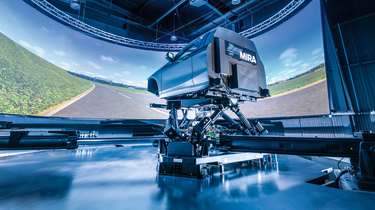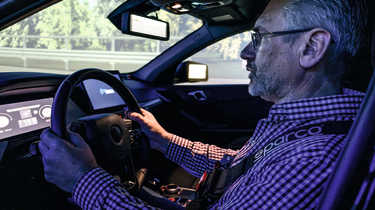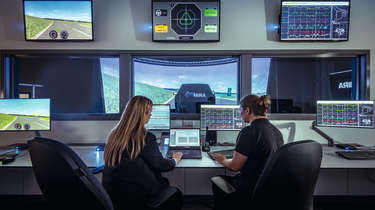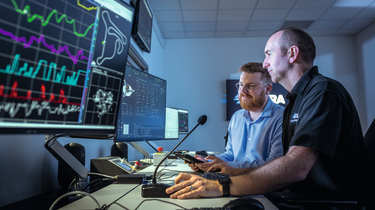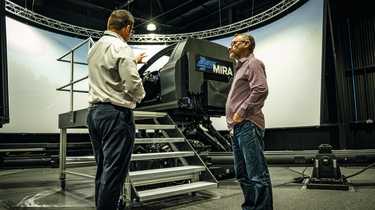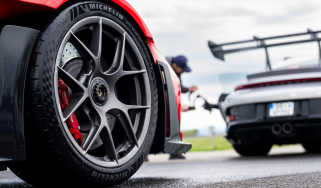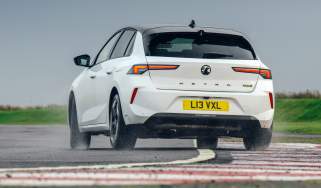Testing the ultimate £4m driving simulator
Can sophisticated driving simulators replace costly, physical prototypes? We visit the new £4m Horiba MIRA simulator complex to take a digital drive
Computer-based virtual engineering has already helped compress vehicle development times and reduce costs. It allows complex engineering solutions to be packaged and tested before a physical prototype has been built, and many car makers now hold highly detailed digital models of their complete cars, and their tyres. Some anticipate that the next step will be to use these models to drive them virtually in a simulator instead of building early, physical engineering prototypes.
That’s the view of Horiba MIRA, the research and development business based near Nuneaton in the Midlands, which has just opened a new £4million driving simulator complex. Its centrepiece is a VI-grade DiM250 Dynamic Simulator, pictured here, which is one of the world’s most advanced multi-axis simulators.
> An unlikely wind tunnel facility in Northamptonshire – Catesby Tunnel
Building the first physical, driveable prototypes of a brand-new model is both expensive and time consuming, and the learning that results from driving and testing them is not definitive. This is because they are often hand-built from a combination of design intent and non-intent parts and so can be unrepresentative in significant areas such as structural rigidity. Also, if engine and gearbox development is ongoing, early drivetrains will also be unrepresentative, while chassis components may also be fabricated rather than ‘off-tool’ and the set-up will be best guess.
Yet despite their lack of maturity, these early prototypes are valuable for confirming proof of concept and may also highlight unforeseen issues. The first drive is a significant milestone in the development cycle of a new model, a real watershed moment, offering the first insight into the dynamic character of the car, how it performs against expectation, what areas are to target or on the right trajectory, and which will need more focus or even a rethink. You need to be able to see beyond the crudeness of the prototype to identify the potential, and that takes skill and experience.
When I was working at JLR I took part in the first assessment drive of the first F-type prototype, which was essentially a cut-and-shut version of the XK convertible. We all felt the car showed promise, but Mike Cross, who headed up Vehicle Integrity, and Jeff Mitchell, his right-hand man, used their vast experience and skill to assess each attribute – steering, ride and handling, performance, sound quality, etc – and give it a score that reflected how far each was away from the agreed programme target.
Guided by their assessment, the prototypes were developed and improved until they were on target in all aspects, and at the required time the next round of funding was released and the project proceeded to the next stage. Could a car’s ‘digital twin’ driven on a simulator facilitate such crucial appraisal and eliminate the need for an early physical prototype?
The VI-grade DiM250 Dynamic Simulator is a staggering bit of kit. It fills a space the size of a small sports hall and has three huge rams to move the motion platform and its cockpit – an actual BMW 1-series shorn of its front and rear ends – horizontally around the ‘baseframe’ surface, plus six smaller rams tilting the cockpit. A wraparound screen provides a 270-degree view and the driver’s seat uses inflatable side bolsters to add more side load feel.
Climb the removable stairs, set your driving position, latch your seat belt and confirm to the control room via the audio link that you’re ready to go and the simulator is initiated, whirring into its start position. It’s an immersive experience, the screen covering your front and peripheral vision. As is usual, the first scene is the ‘infinite highway’, multiple lanes bordered by crash barriers heading away into infinity.
Squeeze the throttle, the engine note rises and there’s a sensation of getting rolling. I make small steering inputs and my deep-rooted, road tester’s sense of what the car is doing compares the feedback with what I was expecting, and there’s a gap. I speed up, try a few more gentle steering inputs and then a few fast lane changes. It’s not as realistic as I was hoping.
For me, the digital car doesn’t respond to steering inputs in an authentic, natural way; the front doesn’t roll slightly as the lock is applied, the rear then following, and there isn’t the sensation of the subtle shift in mass as the car transitions. Bigger lane changes with sharper inputs feel the same, and as I tackle a coned lane change at ever greater speeds, I feel I’m relying as much on visual cues as tactile feedback. The set-up of the model car can be adjusted, making it steer more sharply, for instance, and this comes through in the larger dynamic events, but for me the detail is still absent.
The Horiba MIRA proving ground offers many test surfaces and some have been modelled in the simulator. Driving them in the simulator, the feedback, both physical and audible, is uncanny; over the ridges you get a convincing sense of the wheels on the front and then the rear axle taking the impact. The handling circuit has been modelled too. I’ve driven it a number of times for real so I know its cambers and crests and dips, but in the simulator I’m struggling to feel that the car is in contact through its four contact patches, and the gap between expectation and feedback I’m getting is making me slightly unwell. The VI-grade DiM250 is the best sim I’ve driven and although I could see how it could be useful for assessing A-to-B changes, I can’t imagine using it to tune steering or damping.
However, the issue may be with me rather than the simulator, says Darren Turner. A highly accomplished racer in multiple formulae, Turner speaks from a unique position, having been involved in vehicle simulator development right from the beginning. He was a test driver for the McLaren Formula 1 team back in the late ’90s when they speculatively initiated their simulator programme, unsure at that point whether it would prove an asset. For the last 14 years he has run a company called Base Performance Simulators that coaches drivers young and old, and he has some feedback for me: ‘Generally, younger drivers don’t have a problem adapting to a driving simulator but the older a driver is, generally the less well they adapt.’
This view is endorsed when I watch the in-car view from the control room as a young member of the Horiba MIRA staff takes the wheel and drives around an undulating, twisting circuit, clipping every apex. Both the accuracy of the driving and the remarkable range of movements the simulator goes through are highly impressive.
Simulators are now an integral and valuable part of every F1 team, with dedicated drivers. ‘The current 20-plus race schedule means that the team’s main drivers rarely visit the simulator,’ says Turner. ‘Some teams have developed their own simulators, others have adapted proprietary simulators, and the accuracy of their car models, tyre models and circuit models means that their output is reliable; changes on the sim correlate very well on the actual car.’ And, of course, it’s significantly less expensive and time consuming to run a technical change on multiple circuits in various conditions on a simulator than it is to do the work for real, even if the regulations allowed that.
Can Turner see simulators taking the place of early development prototypes of production cars? ‘Yes, absolutely. Look at the progress of F1 simulators in the last 15 years. It will happen.’ Just as in Formula 1, the incentive for car makers is huge: the potential savings in cost, time and CO2 emissions are simply too great to ignore.
Once the digital twin and simulator have helped advance the project to the next stage – often called verification prototypes, which are made with off-tool parts – the physical prototypes can be driven on proving grounds such as Horiba MIRA and the correlation between physical and digital prototypes established. Once that is achieved, updates and changes to specification – powertrain, chassis, tyres, anything – can be evaluated virtually first with a good level of confidence of what will be realised physically, which saves even more time and cost. It’s a (virtual) virtuous circle.
This story was first featured in evo issue 321.

